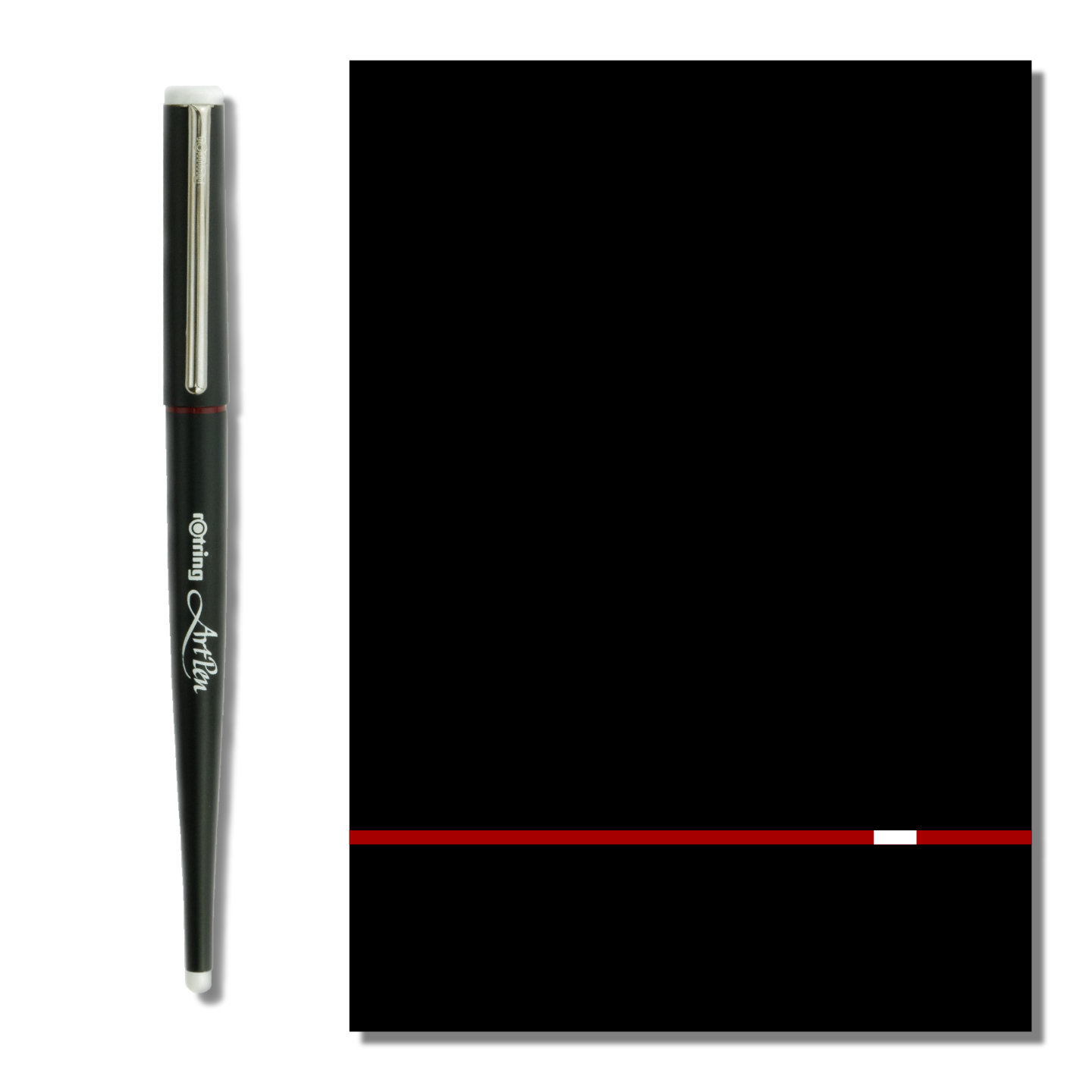When my one-man notebook crafting operation started to wind down after a batch of notebooks made for friends, I decided to finally make a notebook for myself. My first choice was a Seigaiha matcha green one with that amazing Tomoe River 52 g/m2 paper. The scope started to extend to a set, so in the meantime I already started to think about another, more business like notebook with Clairefontaine Clairalfa 90 g/m2 paper.
Rotring design
As I wrote in my story on the About page, my first beloved fountain pen was a Rotring ArtPen. I like its bauhaus design, the color set and that iconic red ring. (Rotring in German literally means red ring.) I decided to experiment with a new notebook that features multiple textile cover layers to achieve a multi-coloured design. The cornerstone of the design was to use the three Rotring colours: dominantly black with a red band and a smaller white rectangle imitating the white barrel finial of the ArtPen.
I thought of using some kind of phosphorescent material, like the ones used on wristwatch hands. However those need to be charged by light. This is not practical with a notebook that is kept in a dark bag or drawer.

Brainstorming geeky features
Then it came to my mind that some watches, like Marathon🔗 army field watches🔗 or Ball watches🔗 use Tritium radioluminescent🔗 vials. Tritium’s half-life of ~12 years is plenty enough, I will have been scribbled this notebook full by then easily. I found a Taiwanese company🔗 selling Tritium vials. Unfortunately the angular ones were available only in red, green and blue but not in white. However I realised that a red vial is even better. When the ambient light is strong enough, the Tritium vial looks just white and the weak light emitted is not perceivable. On the other hand, in darkness, when human eyes can’t pick up colours and the red textile band will look just dark grey, a glowing red rectangle fits the original design idea perfectly.
I figured, why not make this notebook as geeky as possible? I could add a Tile or Apple tag, but I didn’t want to use active electronic components and battery. That would be too much of a gimmick with an overly large environmental footprint. (Not that I felt entirely proud of myself for sourcing Tritium from the other side of the world.)
I was already pondering over integrating magnets into notebook covers, so that was +1 somewhat geeky feature. I was wondering whether some USB storage would make sense but pen drives see less and less use nowadays. So I thought of adding an NFC tag to the notebook. It’s small, passive and can be (re)written with an ordinary smart phone as needed. It can contain my contact details, a link to my website, or used for some kind of fountain pen related automation. (If I were to have an NFC tag in all my pens, I could automate registering daily pen use at fountainpencompanion.com🔗 🤓)
Behold the ultimate geek notebook
After all the parts arrived, I managed to craft the notebook. It’s pretty dope 😎 (Click on the pictograms to reveal the geeky features of the notebook.)
Features
- Neodymium magnet closure
- NFC tag
- Tritium radioluminescence
Neodymium magnet closure
The magnets Keep the notebook shut snug tight 
The magnets are glued into the cardboard covers. Since magnetic field strength drops exponentially with distance and the cover provides limited space, strong neodymium magnets are used.
- Material: NdFeB
- Induction: ~1.42 T - 1.47 T
- Size: Ø 20 mm, height 2 mm
- Pull force: ~3.4 kg
NFC tag
- can store contact details and get shared easily
- can be used to share the link to collected inks🔗 at fountainpencompanion.com
- can contain information in case of loss
- can be used to turn on/off Do not disturb mode of the smart phone before/after a meeting
- the chip can be (re)programmed many times according to needs
Tritium radioluminescence
It's the kind of radiation that is both hot and safe 😄
The notebook emits red light constantly. It's not as strong as the best phosphorescent lumes used by the watch industry. However it doesn't require to be loaded, it works for 10+ years just by itself. Meanwhile it's bright enough to easily spot the notebook at night on a desk without having to turn the light on.
⚠️ Since the notebook contains strong magnet (at least compared to a regular fridge magnet), no equipment sensitive to magnetic fields should be placed near to it (e.g. watches, hard disks)
Lessons learned
First of all, it was a fun project. It’s not that hard at all to embed stuff into the cover. It opens up interesting possibilities and I already have some new ideas.
I was a bit afraid that a 2 mm thin magnet may not be strong enough to keep a notebook shut. Therefore I ordered a magnet with the highest grade of magnetisation available (N52). It was an overkill. Since the magnet is a danger to other stuff lying around on my desk — like a mechanical watch for example — it would have been safer to choose a somewhat weaker magnet.
I’m thinking about making a pen pouch incorporating some magnetic material so that I can secure my pen to the magnetic closure of the notebook. The clip of the Rotring ArtPen itself is some sort of steel and sticks firmly to the magnet inside the notebook cover 😎
This project involved several different materials. I’ve used four kinds of glue, including a strong & transparent one that adheres well to acrylic and can be cured by exposing it to UV light.
